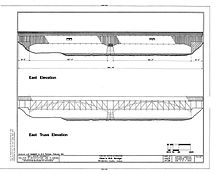Burr truss


A Burr Truss or Burr Arch Truss is the name given to a construction that combines arched and half-timbered construction . The construction technology was developed by Theodore Burr in 1804 and is mainly used for roofed wooden bridges in North America.
features
The basic idea behind the construction is that the arch bears the entire weight of the bridge, while the truss stabilizes the bridge. Although a half-timbered construction could also bear the weight, arched bridges also dissipate the dynamic horizontal forces that arise when the vehicles accelerate and brake on the bridge in the form of tensile and compressive forces. On girder bridges, such forces generate less favorable bending moments on the columns.
In the literature the view is partly taken that the truss carries the weight of the bridge and the arch stabilizes the bridge. Regardless of how it works, a Burr truss bridge is more stable than an arch or girder bridge.
Single receipts
- ↑ a b The Burr Truss . In: Truss Styles of Covered Bridges . New York State Covered Bridge Society. Retrieved January 7, 2018.
- ↑ Truss Types . In: Covered Bridge Truss Types . Ohio Department of Transportation Office of Structural Engineering. Archived from the original on May 12, 2008. Retrieved September 15, 2006.
- ↑ Truss Types . The Theodore Burr Covered Bridge Society of PA, Inc. Retrieved January 26, 2011.
- ^ JB Calvert: The Burr Truss . October 23, 2000. Retrieved July 28, 2006.